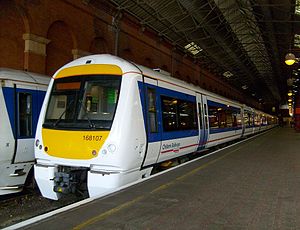- British Rail Class 168
-
British Rail Class 168 Clubman
Chiltern Railways Class 168/1 No. 168107 at Marylebone.
Refurbished Class 168/1 Interior.In service 1998 - present Manufacturer ADtranz, Bombardier Family name Turbostar Constructed 1998 - 2004 Refurbishment 2007 - 2008[1] Number built 19 trainsets Formation 3 or 4 cars per trainset Fleet numbers 168001 - 168005
168106 - 168113
168214 - 168219Capacity ? seats Operator Chiltern Railways Line(s) served Chiltern Main Line
London to Aylesbury LineSpecifications Car body construction Welded aluminium. Steel ends. Car length 23.62 m (77 ft 6 in) Width 2.69 m (8 ft 10 in) Height 3.77 m (12 ft 4 in) Maximum speed 100 mph (160 km/h) Engine(s) One per car, 422 hp (315 kW)
MTU 6R 183TD DieselTransmission Voith Hydraulic T211rzze
2 axles driven per carSafety system(s) ATP, AWS, TPWS, Tripcock system Coupling system BSI[2] Gauge 1,435 mm (4 ft 8 1⁄2 in) Standard gauge The Class 168 Clubman is a diesel multiple-unit (DMU) train used on services between London and the Midlands.
Contents
Description
The units were built in several batches from 1997 onwards. The first batch of units was classified 168/0 under TOPS and resembled the Class 165 units previously built by BREL at York. The Networker-design cab was an interim solution pending the design of a completely new cab for further Turbostar batches. Subsequent builds, which are subclassed as 168/1 and 168/2, were constructed at the same time as the Class 170 Turbostar and thus are part of the Turbostar family of trains.
The first batch of Clubman carriages ordered by Chiltern Railways were the first units to be ordered by any train operating company since the privatisation of the UK industry in 1996. They were originally delivered as 3 car sets but were later lengthened to 4 car sets. The Midland Mainline Class 170/1 were the first production Class 170 Turbostars to be constructed and are based on the experience learnt from the Class 168.
Technical details
The Clubman/Turbostar platform is a modular design, optimised for speedy manufacture and easy maintenance. It consists of an underframe, which is created by seam-welding a number of extrusions, upon which bodyside panels are mounted followed by a single piece roof, again made from extruded sections.
The car ends are made from glass-reinforced plastic and steel, and are bolted on. Underframe components are collected in ‘rafts’, which are bolted into slots on the underframe extrusion.
The drive system consists of a MTU diesel engine with a two speed Voith T211r hydrodynamic transmission system. This is the same gearbox as previously used on all Sprinter variations. A cardan shaft links the output of the gearbox to ZF final drives on the inner bogie of each vehicle.[clarification needed]
Automatic Train Protection (ATP) equipment, manufactured by Alcatel is fitted as well as a tripcock system for operation on tracks shared with London Underground.
Seating
A typical Class 168 consists of 2+2 standard class seating throughout, arranged either round tables or in airline style seating with pull-down tables. The majority of seats are facing seats. The Class 168 is carpeted throughout with luggage racks, air conditioning, and two or more toilets per set (one for disabled users, with baby changing facilities).
Passenger information systems are in fitted every car and on the outside of class 168/2 cars. The Clubman fleet has problems with its passenger information system, which is based on GPRS and GSM technology, but frequently fails to accurately find its position, resulting in misleading information being displayed to passengers.[citation needed]
Variants
Three different variants of the 168 have been produced - they are 168/0, 168/1 and 168/2 - both Classes 168/1 and 168/2 are actually of the same design as the Class 170 Turbostar DMU trains, mainly due to the redesigned cab ends.
Class Operator No. Built Year Built Cars per Set Unit nos. Class 168/0 Chiltern Railways 5 1998 4 168001 - 168005 Class 168/1 8 2000 168106 - 168107 3 168108 - 168113 Class 168/2 6 2004 168214, 168218 - 168219 4 168215 - 168217 Operations
Network South East (NSE) originally planned the Class 168 for their expansion of service on the Chiltern Main Line to Birmingham Snow Hill or New Street. These units were planned to have higher top speed of 100 mph (160 km/h) and better acceleration than the Class 165 Network Turbo DMU trains.
In the event, privatisation intervened before NSE acquired any units; Chiltern Railways operates these units, in similar diagrams to those originally planned by NSE.
Liveries and interiors
References
- ^ Chiltern Railways. "Chiltern Railways: About us - Our train fleet". http://www.chilternrailways.co.uk/about-us/our-train-fleet/. Retrieved 2010-08-23.
- ^ "System Data for Mechanical and Electrical Coupling of Rail Vehicles". Rail Safety and Standards Board. http://www.rssb.co.uk/rv_coupling_system_data/list_index.asp. Retrieved 2009-01-05.[dead link]
Bombardier Turbostar and Electrostar family Turbostar family: Electrostar family: Diesel multiple units of the United Kingdom First generation units: First Generation
Original TOPS:First generation units
(pre-TOPS):British United Traction · Derby Lightweight · Metro-Cammell · Railbus · GWR Railcars · LMS Railcars
Second generation units: Diesel-electric units: Southern Railway designations: Families Categories:- British Rail diesel multiple units
- Adtranz multiple units
Wikimedia Foundation. 2010.







